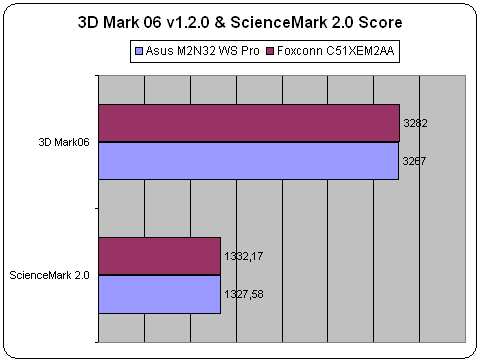Foxconn C51XEM2AA Motherboard
5. The Tests
Review Pages
In order to test the Foxconn C51XEM2AA motherboard, we used the following setup. The same setup had been used on the ASUS M2N32 WS Pro which we will be using here for comparison:
- CPU: AMD Athlon 64 X2 4600+ AM2
- Memory: Mushkin 2x512MB PC2-6400 (DDR2 800)
- PSU: OCZ GameXStream GXS600 SLI-Ready
- HDD: WD 800JB
Both the ASUS M2N32 WS Pro and Foxconn C51XEM2AA are based on the same chipset, Nvidia's 590SLI. Below are the test results as reported by Lavasys Everest Ultimate Edition 2006.

We notice that the Foxconn motherboard was faster in all memory tests. On the other hand, Asus has a slight lead in the CPU tests. Let's have a look and see what the Sisoft Sandra 2007 SP1 results have to add.

There's very little between the two boards and the only noticeable difference is in the Cache and Memory index.
PC Mark 05 offers a suite of tests for memory and CPU speed:

Again, the difference is negligible. The overall score of 5575 for the Foxconn motherboard is very good.

In the 3D Mark 06 and ScienceMark 2.0 benchmark tests, there are again only slight differences between the two boards.
Lastly, we tried SuperPI 4M calculation, but there was no real differences here either, just 2secs in favor of the Foxconn motherboard. In the HL2 Episode 1 benchmark, there was only 1 FPS difference.
- Overclocking
Foxconn uses Nvidia Tune, and offers several advantages over conventional overclocking methods. Within NTune, you can set ALL bios settings:

As well as change, on-the-fly, the FSB, Memory voltage, timings and fan speed (click to enlarge):
Lastly, you can perform stability tests, to stretch test your system when overclocking.

Ntune can look for the best possible combination, automatically trying to find the best possible overclocking speeds for your memory, CPU and VGA. For our tests, we used only memory and CPU OC, and the highest results we got were 230MHz for the FSB, resulting in 2767.5GHz!

Below is what CPU-Z reported. Using the Ntune stability tests didn't indicate there would be any problems. However, after running two instances of Prime95, we realised that such high overclocking was risky since we got errors. Reducing the FSB to 226MHz resulted in a rock solid overclocked system, without any errors. That's slightly higher than what we had with the ASUS M2N32WS Pro (224MHz FSB):

Review Pages






















